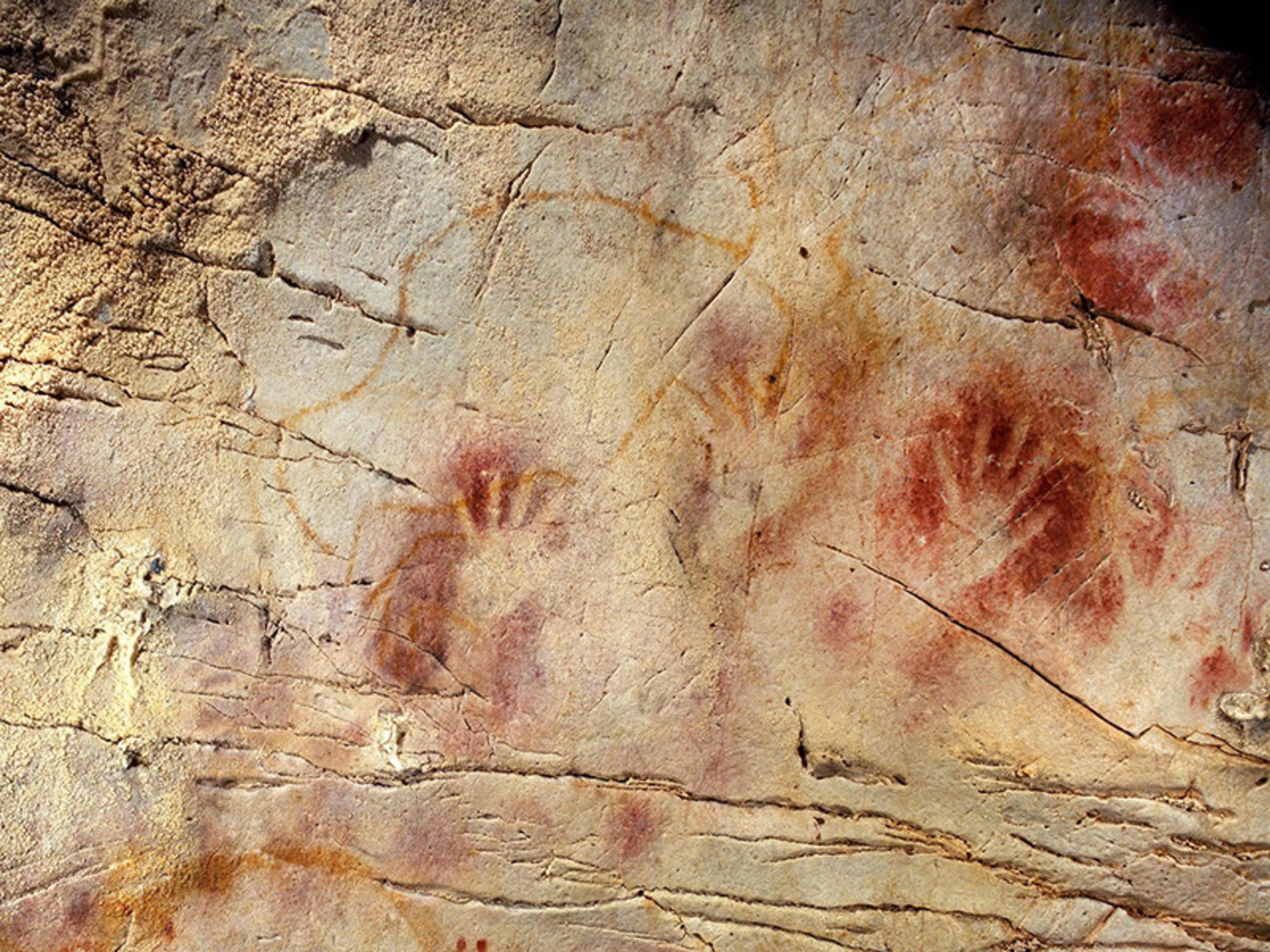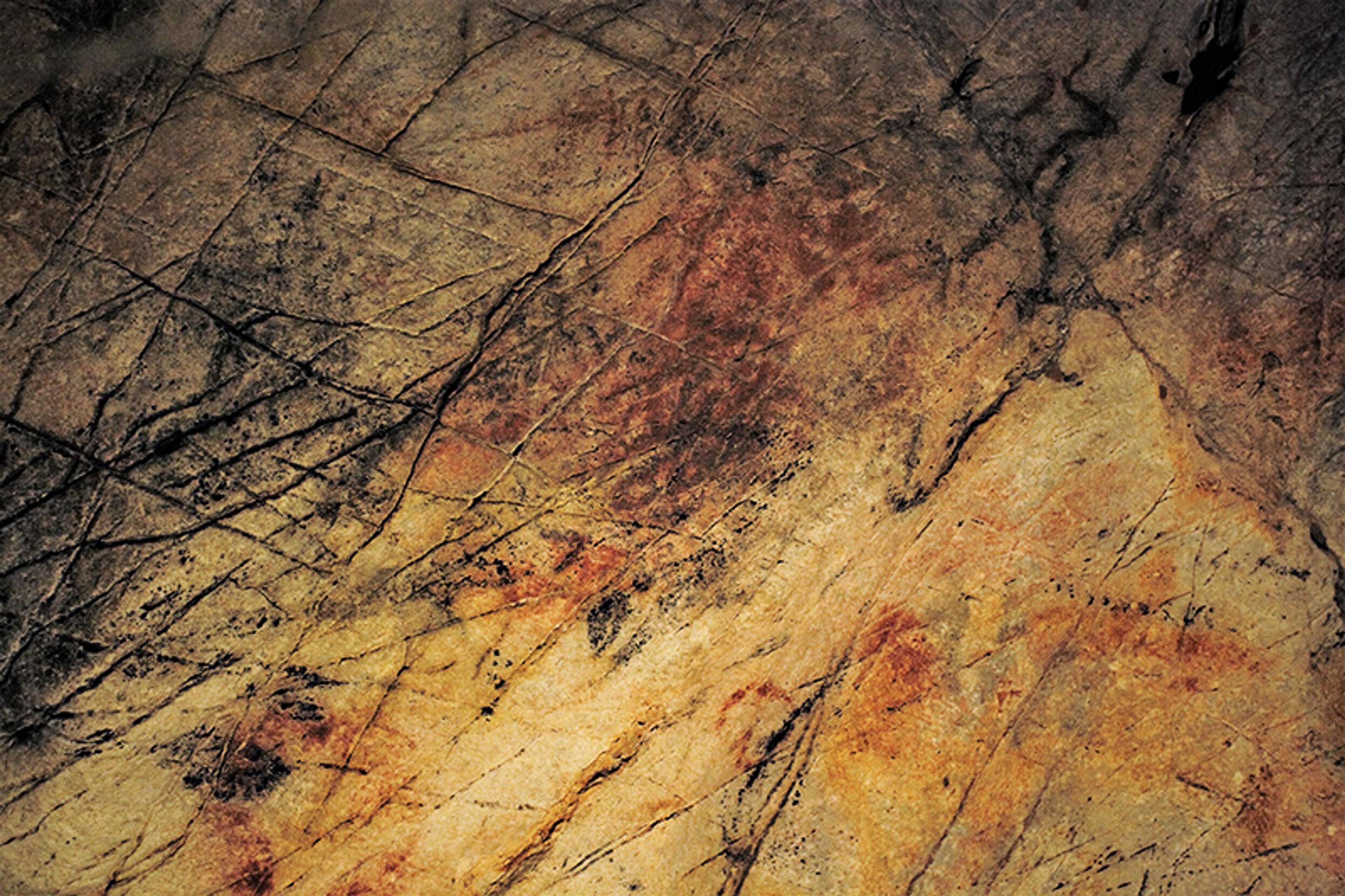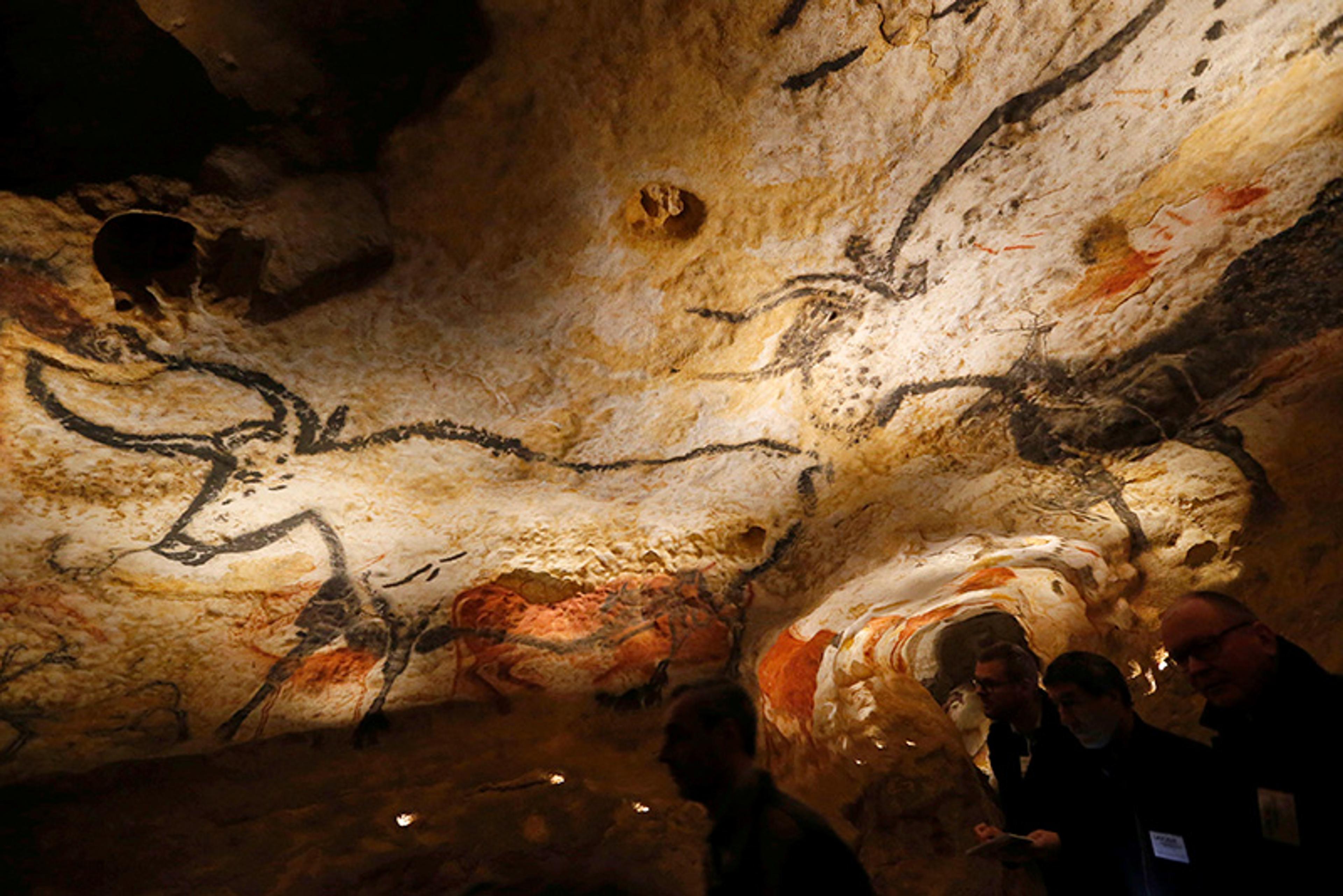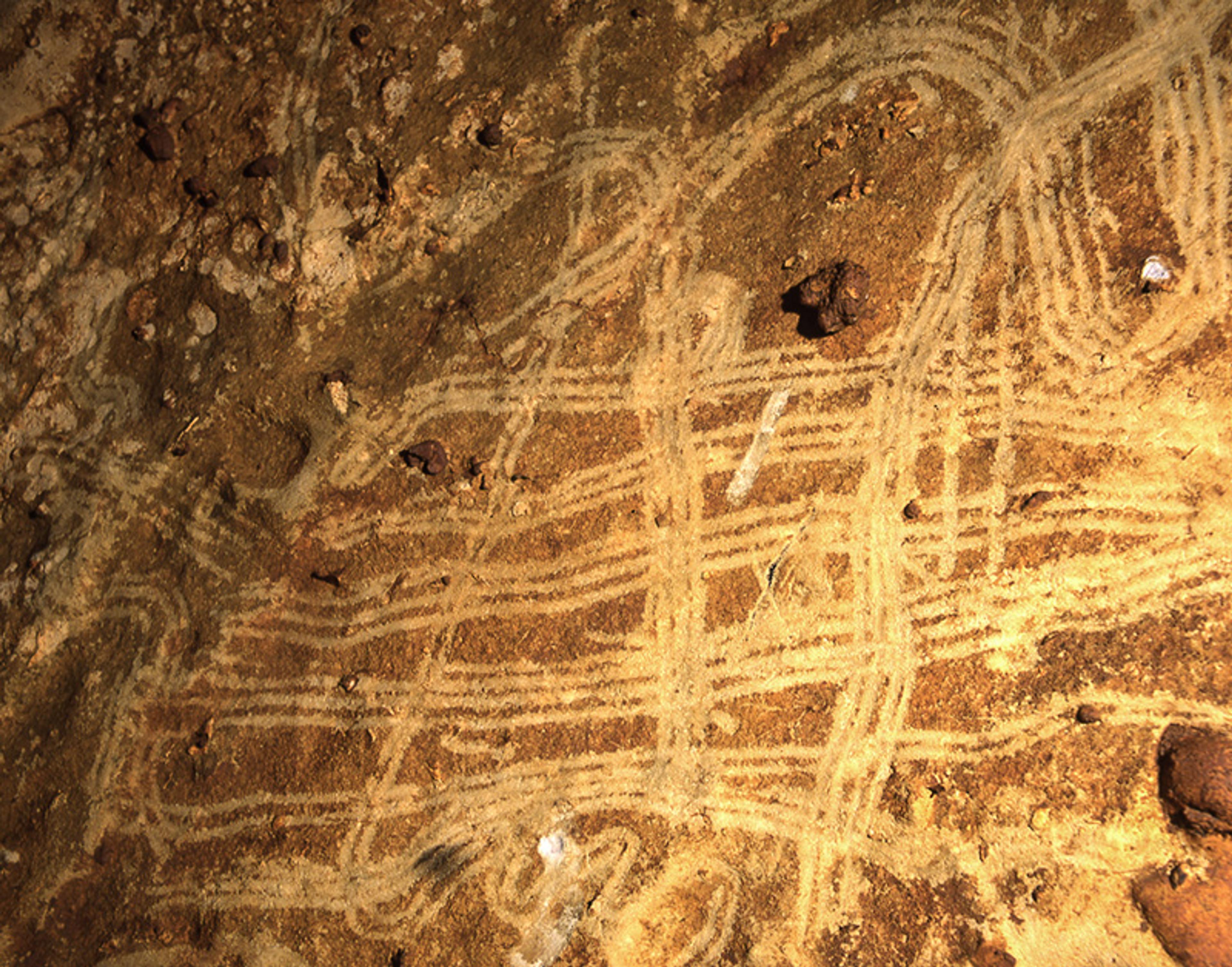Squeezing through a small opening at the back of a rock shelter, a young hunter-gatherer finds herself in an environment far removed from the comfort of her home. Blinking as her eyes adjust to the low light cast by the flame of her torch, she observes a vast otherworldly space before her. As she explores, she notices unusual markings on the walls. Edging closer, she sees the large face of a red painted bison, facing downwards, imposing its presence upon the space. She notices smaller depictions to the left; stencils of hands from people who had explored this cave before her. Placing her hands to meet the hands of her ancestors, she feels a deep emotional connection to this environment.

She glances up and spots two small deer drawn above the hands, the first a little faded. Taking a piece of charcoal from her pouch, she redraws the faded deer to recapture its vibrancy. She’s close to the wall now, with the small light from her torch casting elongated, flickering shadows over the contours and cracks that appear to take the form of another bison. This intangible image, flickering in and out of her perception, holds deep cultural significance for her; bison are the providers of meat and hides that keep her and her family fed and warm, ensuring their survival within the harsh climate of the last Ice Age. She uses the same charcoal piece to re-draw this image, coaxing the bison from out of the rock, and depicts it as resting, with legs curled underneath its body. She ensures the deer are still visible, creating a palimpsest of connection between her, her ancestors and the animals that held importance to them.

Nearly 20,000 years later, the distant descendant of this young cave explorer wanders into a brightly lit white room. A small red rope separates her from a flat canvas, busy with colour, hanging on a plain white wall. She contemplates it, appreciating the naturalism of the subjects in the depiction, the violence and emotion it captures, before moving on to observe a similar canvas hanging next to it. Small signs next to these canvases show a hand, but with a large red cross through it, indicating not to touch the art on the wall; it is priceless, painted hundreds of years ago, and should be appreciated at a distance. After observing these canvases, she steps outside, to see someone furiously attempting to remove a small, colourful image sprayed onto the wall of the building.
The way that we place value on art in the Western world is distinctly odd. It is, for the most part, a luxury or a commodity more or less isolated from other aspects of society. We evoke sentiments of the psychologist Abraham Maslow’s hierarchy of needs when discussing the role of art: we live in a society where our basic needs are met, and therefore can indulge in the frivolous activity of art-making. There are exceptions, of course, such as political and religious art. But it’s rare to see art that is intrinsically woven into, and ultimately shapes, the very fabric of society. Was art always destined to be something that came only after we had satisfied our basic subsistence needs? Human evolution suggests not.
Art-making is one of the oldest human behaviours – it seems to have its origins hundreds of thousands of years ago. Two of the earliest art forms in the archaeological record are impossibly old: the Tan-Tan figurine and the Berekhat Ram figurine date to around 500,000 to 300,000, and 250,000 years ago, respectively. Both of these ‘proto-figurines’, despite potentially being separated from each other by as many years as we are separated from the youngest of these figurines, are recognisably works of art. They are naturally humanoid-shaped rocks that were intentionally modified to further bring out human features. While we don’t know exactly which species produced these, they certainly weren’t Homo sapiens and instead were likely one of our distant ancestors: either Homo erectus or Homo heidelbergensis. This desire to create and to represent appears to have been embedded within our genus and intertwined with our evolution; as human evolution progressed, artistic behaviours became more complex and diverse.
Even our closest evolutionary cousins, the Neanderthals, although often unfairly presented as knuckle-dragging brutes, engaged in a plethora of artistic behaviours. Recent evidence suggests that they produced some of the oldest examples of painting, using natural pigments to create abstract depictions and hand-stencils on cave walls more than 70,000 years ago. Neanderthals even used natural pigments, feathers and beads made from shell and animal teeth to decorate their own bodies. In the past decade, archaeologists have found abundant evidence from Neanderthal contexts in sites across Europe of large raptor bones with cut marks to remove their flight feathers, talons that have been coloured with pigment and modified for suspension, shells and animal teeth with holes in them that have wear patterns consistent with being strung as jewellery, and evidence of pigments, such as ochre, being mixed in large shells to create a body paint. This evidence for Neanderthals creating a rich artistic material culture was, and still is, met with much resistance in the archaeological community. We want to believe that art is unique to our species, a behaviour that set us apart, but without asking why it held so much value to the very earliest human societies.
Cave art remains fixed in place, undisturbed, in exquisite time capsules of human behaviour
Ice Age, or Upper Palaeolithic, societies might hold some of the answers about why we create art. Artistic behaviours seem to have flourished during the Upper Palaeolithic, giving birth to something like a renaissance of art production; for many years this period was referred to as a ‘cultural explosion’ or ‘revolution’. These Ice Age artists produced a huge number of diverse artefacts and paintings during this period. Some of these are unusual decorative items used to adorn the body, marked with abstract designs, but others are more familiar and recognisable: representational figurines and depictions of animals that roamed the Ice Age world. While this representational art might superficially appear akin to our own artistic behaviours, a closer look reveals the sometimes weird and wonderful ways this art was used tens of thousands of years ago: beautiful clay figurines of animals were created to be destroyed through intentionally causing them to explode in fires; shells were transported and exchanged across thousands of kilometres; beads were made from animal and human teeth; and large red-painted horses were sculpted into hillsides. But the most intriguing category among all of this is cave art.

Found most famously in France and Spain at sites such as Lascaux, cave art has also been discovered at a wide range of different places, from the Cueva de las Manos in Argentina and the Lubang Jeriji Saléh cave in Borneo to the caves of Creswell Crags in Britain. Cave art is a breathtaking example of the extent of creativity during the Upper Palaeolithic; not only are we perplexed by the artists’ desire to venture deep underground to make this art (sometimes up to 2 km in from the cave mouth), but we are fortunate enough to be able to see it as it was intended to be viewed, often in superb condition. Unlike beads or figurines, cave art remains fixed in place, undisturbed, in exquisite time capsules of human behaviour.
To explore the importance of art to these most ancient of human societies, we need to delve into some of these time capsules and immerse ourselves in the Upper Palaeolithic world.
Lascaux cave, France, c17,000 years ago. This is the most famous cave-art site in the world; the vibrant polychrome images of this art are plastered over coffee table books on human evolution, and hundreds of thousands of people visit the third iteration of the Lascaux reconstruction each year. The popularity of this cave isn’t surprising. The vast composition of highly detailed animal depictions inspires awe and fascination for anyone fortunate enough to enter the cave. The almost ‘rhythmic sequence’ behind the placement of each animal offers a sense of narrative, one that is long forgotten in deep time. Although the art is situated underground, the visually imposing depictions were intended to be viewed by a sizeable audience. More than 100 lamps were found within the cave, made from stone with a depression to hold animal fat and a wick, akin to modern candles; these might have been used as installation lighting, spotlighting the art within the darkness of the cave. The diffuse, flickering light cast by the flames would have created an immersive experience for our Palaeolithic audience. Dancing light and shadows brought the art to life, evoking a sense of movement and dynamism – the closest thing to Ice Age cinema.
The animals themselves were depicted as galloping across the cave wall, creeping out of small fissures or falling into the darkness. The acrid smell of smoke and melting fat, the warmth of the dim flames and the echoing sounds within the cave as stories about the animals were richly woven would have heightened the experience of viewing this art. One can picture how these flickering images, coupled with the telling of a story passed down through generations, imbued a sense of kinship and connection between Palaeolithic people and the animals depicted, with whom they shared the frozen landscape outside. This emotive, communal experience perhaps enriched a sense of belonging and rooted a deep understanding of their place within the world. It’s far from how we might observe art today, in quiet reflection; instead, it was likely a performance intended to build relationships between the observer and the animals that they relied on for their survival.
El Castillo cave, Spain, c40,000 to 15,000 years ago. If Lascaux is a cave of performance and rich cultural meaning, the art of El Castillo can be characterised as intimate and discrete moments shared only between the artists and the cave. Unlike Lascaux, most of the cave art here is hidden and tucked away within nooks and natural features, not intended to be viewed by anyone other than the artist who created it – like a stone carving in an inaccessible part of a cathedral. It isn’t a single composition, but instead a palimpsest of multiple, meaningful connections that stretch across vast swathes of time. The oldest art in this cave is red discs created more than 40,000 years ago by people blowing pigment onto the wall. Yet the most recent art in this cave was created a mere 15,000 years ago. It’s quite incredible and humbling to encounter a single site encompassing 25,000 years of art-making.
It wasn’t the final form that was of importance, but the process of making it that held meaning
The ‘Panel of Hands’ best characterises this within El Castillo. The implicit presence of generations of hands that were placed on the cave wall are captured and preserved in a red ochre pigment, which was blown from the mouths of our distant ancestors. These hand-stencils tangibly connect us to Upper Palaeolithic people; we can reach out across the ages and almost touch our hands with theirs. This probably evoked a similar sense of connection in the Upper Palaeolithic. The hand-stencils within the cave are old, dating to at least 37,000 years ago. The multiple generations of people who traversed and explored this cave since would have similarly cast their eyes on these hands. They might not have recognised the deep age of the hand-stencils, but would have understood that they represented the implicit presence of people who had been in the cave before them, as they would have understood tracks of the animals they hunted. They might even have felt moved to produce their own hand-stencils, adding to a long tradition of intimate connection; some hand-stencils in this cave date to around 25,000 years ago, created 12,000 years after the oldest hand-stencils in this cave.
Within El Castillo, too, there are depictions of animals intentionally hidden from view. This lack of visibility suggests it wasn’t the final form that was of importance, but the process of making it that held meaning. Natural suggestive features were frequently incorporated into the depiction of animals in El Castillo, and it has been suggested that these ambiguous visual cues might have triggered a psychological response known as ‘hyperimagery’: a familiar experience to those who have woken up in the middle of the night and misinterpreted the coat hanging on the back of a door as a person standing in the room.
The darkness of caves and unfamiliar features under the flickering flame of a simple torch would have heightened the effect of hyperimagery. Those within the cave might have seen the forms of animals emerging from the cave wall as their visual system tried to make sense of their surroundings, attuned as they were to the forms of these animals in the world outside. Perceiving these animals that were crucial for their survival, waxing and waning into focus within the darkness, was likely layered with rich meaning, inspiring the artist to make these fleeting images palpable. In doing so, they solidified a relationship between themselves, the sensory environment of the cave and the animals they were depicting. This cave is typified by these preserved, intimate moments that stretch across millennia, and throws into sharp relief the importance of appreciating the making of art, rather than its final form. For the artists of El Castillo, this process allowed them to build relations between themselves, the animals around them and their ancestors, with the art itself being an agent in constructing these relationships.
Rouffignac cave, France, c13,000 years ago. This cave is revered for its numerous depictions of mammoths: there are 158 in all, which accounts for around 70 per cent of all depictions at this site. The cave itself is also a rich resource for flint, and this might have been the initial reason for entering it. However, the art can’t be dismissed as the actions of some bored person doodling on the walls as they searched for resources. It is placed deep within the cave, far beyond the necessary depth required to acquire flint nodules. In fact, if you want to visit the cave art today, you have to do so by riding a small mining train that carries you into the darkness. Our Palaeolithic artists would have had to plan for venturing this deep underground, taking appropriate resources to replenish their light sources and to ensure that they could return back to the surface. Although in one sense they might have felt safe within the cave, particularly as this was likely a group adventure, it would also have been frightening. Not only were they plunged into an all-encompassing darkness as they moved deeper into the cave, they also would have been wary of anything that might have been lurking in the dark: cave bears liked to hibernate in these safe, cosy environments, and wouldn’t have taken too kindly to being disturbed.
As with El Castillo, the flickering light and shadows cast by their flames, playing across the bumpy surface of flint nodules embedded in the wall perhaps reminded them of the shape of mammoths’ backs. Inspired by this, they depicted mammoths in varied ways; some appear to be greeting each other, with trunks intertwined, and some are incomplete, with just a single line used as a shorthand to capture the mammoth form. At one of the deepest points within this cave, a small chamber (known as the ‘Grand Ceiling’) is plastered with depictions of mammoth, bison, ibex and rhinoceros – 66 animals are packed on the walls of this restricted area, and no space is left blank. This is a kind of Ice Age Sistine Chapel.
The figures are superimposed and intertwined, capturing the essence of a landscape populated by different species. This was perhaps intentional; depicting the movement and interactions of numerous animals as they traversed the landscape built a tangible connection between this unfamiliar, eerie space and the familiar world outside. Maybe this reassured the explorers, making the unfamiliar familiar through animal depictions, or it might have held a deeper meaning within the society, through drawing on the animals to populate this space so distant from the outside world, as a kind of externalised dream. Although there is a sense of narrative here, with animals moving past each other and interacting, the position of this art deep within the cave suggests that it wasn’t created with the intention of being frequently revisited. It’s more likely that this was created in one brief moment in time, preserving the emotion and acute visual memories of the artists submerged within an unknown environment.
Art becomes a cultural memory of vital information passed from generation to generation
There is also an element of play, adventure and exploration embedded within the making of the art at this site. Finger flutings, made by running fingers through the soft clay ‘moon milk’ surface of cave walls, are found in Rouffignac cave and appear to have been predominately made by children and adolescents, giving us glimpses of intimate and very familiar human behaviour. One example appears to have been made by a child no older than five years, but it’s at a height that suggests the child was held at the hip of an adult so that it could join in with the making of these flutings. In this instance, the art made appears to have served no greater purpose than the tactile interaction of running fingers across a wall and the joy of seeing this action leave a mark behind. It’s a distinctly human behaviour, one that we can all vividly picture, appreciating the enjoyment it would have involved: the quiet exploration of the cave beforehand, suddenly broken by the sound of children squealing with laughter as they run their fingers across the wall, with adults cautiously supervising and occasionally, but perhaps reluctantly, helping the youngest to reach higher.

Although the themes embodied within these time capsules of human behaviour – storytelling, connection, play – might seem superficially trivial, they were crucial to the function of society and to survival within the harsh, unforgiving environment of the last Ice Age. The depictions of animals are deliberately accurate in their representation of certain features and behaviour. The animals aren’t depicted as static, but in different positions of alertness or responsiveness, which would have been essential knowledge for a Palaeolithic hunter. People relied on this information about animals for hunting. Knowledge about animal behaviours and migration is much easier to pass on when woven into the narrative of a story brought to life with artistic representations; the art becomes a cultural memory of vital information passed from generation to generation.
For Palaeolithic societies, orientating themselves around the animals that they depended upon ensured their survival. It might even have been a key adaptation that enabled information transmission and encoded the memory of their predecessors, long before the emergence of formal writing or systems of communication. Hand-stencils and a connection to ancestors reminded them that the place they inhabited had been a haven for generations of people, and that they were one in a long line to have visited the cave. Even the play of children was beneficial to society, sparking their own curiosity and creativity – the very creativity that would have been crucial for making cultural leaps in technology. Art was far more than a pleasant pastime that our distant ancestors indulged in; it was interwoven within the function of these Upper Palaeolithic societies and was integral to their way of life. The young hunter-gatherer who squeezed through the gap in the rock shelter would have emerged blinking into the light, transformed by her encounter with her ancestors and with the images of the animals that were essential to her group’s survival.
To read more about the role of art in human experience, visit Aeon’s sister site, Psyche, a new digital magazine that illuminates the human condition through three prisms: mental health; the perennial question of ‘how to live’; and the artistic and transcendent facets of life.






